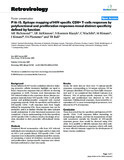| dc.description.abstract | Background
Recent failures of HIV vaccine candidates aimed at inducing
protective cellular immunity highlight our need to
better characterize responses that are effective in slowing
progression to AIDS. Previous work demonstrates that
HIV infected subjects who experience slower disease progression
maintain better HIV-specific CD8+ T-cell proliferation
and polyfunctionality compared with normal
progressing controls. While the specificity and breadth of
HIV-specific CD8+ T-cell responses have been largely
defined by measuring IFNγ, these responses may not be
protective, and it is unclear whether the same epitopes
would predominate if other functional parameters were
considered. A better understanding of the fine specificity
of HIV-specific CD8+ T-cells is critical to the design of vaccines
intended to elicit protective cell-mediated immunity.
Methods
Peripheral blood mononuclear cells from HIV infected
individuals were stimulated overnight and for 6 days with
an HIV-1 p24 peptide library. HIV-specific CD8+ T-cell
responses were evaluated by polyfunctional flow cytometry
measuring a variety of cytokines, cytotoxic potential,
and proliferation. Eptiope-specific responses were identified
and confirmed at a later time point.
Results
Across the entire data set there were 73 epitope-specific
responses, corresponding to 54 unique epitopes. Of the
54 epitopes identified, 42 have not been fully characterized
and 12 are considered Best Defined Epitopes (Los
Alamos). 74% of epitope-specific responses were IFNγ
negative and proliferation was observed in 18% of
responses. Polyfunctional responses, characterized by coexpression
of 2 or more immunological parameters, were
detected in 47% of responses.
Conclusion
These data reveal that the specificity and function of HIVspecific
CD8+ T-cell responses differs depending on
immunologic readout, and that the measurement of multiple
parameters extends the breadth of HIV-specific
responses greater than would be detected using IFNγ
alone. It is possible to identify epitopes that elicit polyfunctional
and proliferation responses, which will result
in more effective immune targets for the development of
future vaccine candidates. | |

